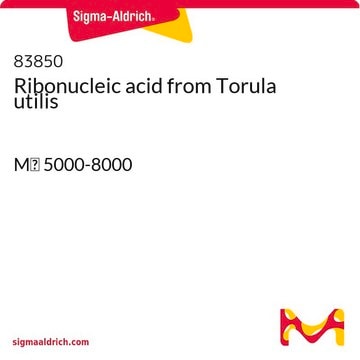R6625
Ribonucleic acid from torula yeast
Type VI
Synonym(s):
RNA
Sign Into View Organizational & Contract Pricing
All Photos(3)
About This Item
Recommended Products
type
Type VI
storage temp.
−20°C
Looking for similar products? Visit Product Comparison Guide
General description
Ribonucleic Acid (RNA) from torula yeast is the substrate for the RNase enzyme. The isolation of RNA from yeast is a complicated process and involves heating and freezing cycles of cells in the presence of phenyl and detergents (SDS).
Application
Ribonucleic Acid (RNA) is suitable for applications such as northern blot hybridization, reverse transcriptase-polymerase chain reaction (RTPCR), and cDNA construction.
Ribonucleic acid (RNA) from torula yeast may be used as a substrate for studying ribonuclease activities of enzymes such as ribonuclease-A, ribonuclease T1 (RNAase), and bougainvillea xbuttiana antiviral protein 1 (BBAP1)
Ribonucleic acid (RNA) from torula yeast may be used as a substrate for studying ribonuclease activities of enzymes such as ribonuclease-A, ribonuclease T1 (RNAase), and bougainvillea xbuttiana antiviral protein 1 (BBAP1)
Quality
Phosphorus: 8.0-10.0% (anhydrous)
Storage Class
11 - Combustible Solids
wgk_germany
WGK 3
flash_point_f
Not applicable
flash_point_c
Not applicable
ppe
Eyeshields, Gloves, type N95 (US)
Certificates of Analysis (COA)
Search for Certificates of Analysis (COA) by entering the products Lot/Batch Number. Lot and Batch Numbers can be found on a product’s label following the words ‘Lot’ or ‘Batch’.
Already Own This Product?
Find documentation for the products that you have recently purchased in the Document Library.
Customers Also Viewed
Jay S Petrick et al.
Regulatory toxicology and pharmacology : RTP, 81, 57-68 (2016-10-30)
Genetically modified (GM) crops have been developed and commercialized that utilize double stranded RNAs (dsRNA) to suppress a target gene(s), producing virus resistance, nutritional and quality traits. MON 87411 is a GM maize variety that leverages dsRNAs to selectively control
Michael R Green et al.
Cold Spring Harbor protocols, 2021(12) (2021-12-03)
Isolation of RNA from yeast is complicated by the need to first break the thick, rigid cell wall. The protocol provided here uses a cycle of heating and freezing of cells in the presence of phenol and the detergent sodium
Stephanie L Grillo et al.
Purinergic signalling, 15(3), 327-342 (2019-07-06)
Adenosine is an endogenous nucleoside in the central nervous system that acts on adenosine receptors. These are G protein-coupled receptors that have four known subtypes: A1, A2A, A2B, and A3 receptors. In the present study, we aimed to map the
Shahab M Danesh et al.
Gene expression patterns : GEP, 9(5), 255-265 (2009-04-28)
Cell-cell communication is critical for regulating embryonic organ growth and differentiation. The Bone Morphogenetic Protein (BMP) family of transforming growth factor beta (TGFbeta) molecules represents one class of such cell-cell signaling molecules that regulate the morphogenesis of several organs. Due
Jesus E Martinez-Lopez et al.
Frontiers in neuroanatomy, 9, 12-12 (2015-03-06)
In the study of central nervous system morphogenesis, the identification of new molecular markers allows us to identify domains along the antero-posterior and dorso-ventral (DV) axes. In the past years, the alar and basal plates of the midbrain have been
Our team of scientists has experience in all areas of research including Life Science, Material Science, Chemical Synthesis, Chromatography, Analytical and many others.
Contact Technical Service








